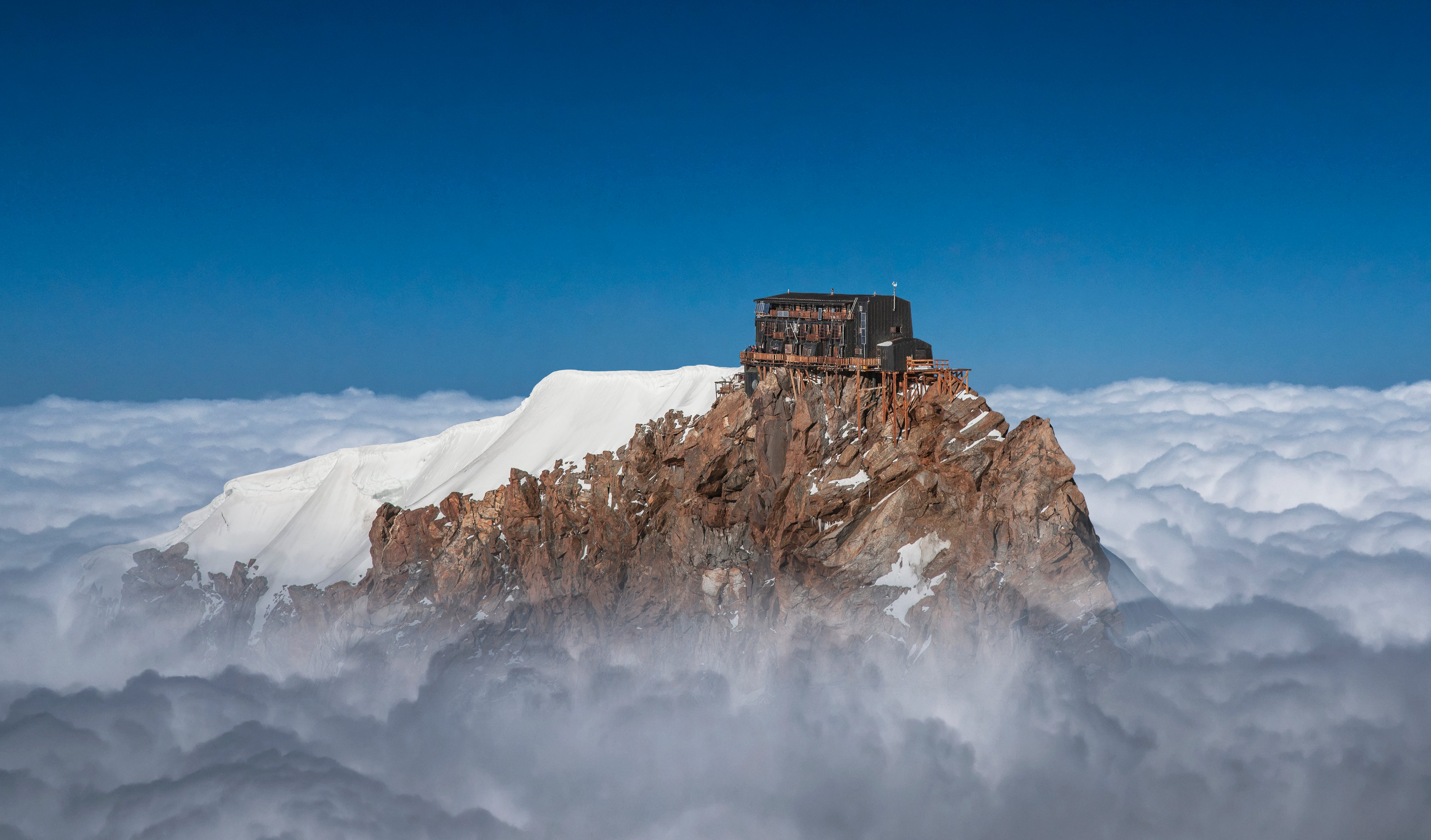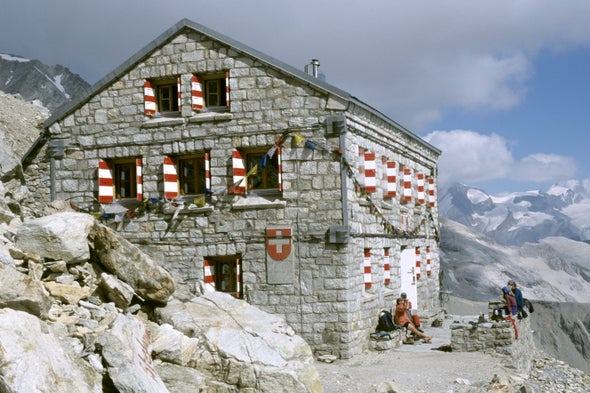Mountaineers have visited Rifugio Casati, a four-story building 10,725 feet above sea level in the Italian Alps, for nearly a century. In 2016 Renato Alberti, who had overseen the structure for 35 years, noticed a vertical crack in one of the outer walls. Alberti, now age 67, filled the gap with repair foam, but the crack reopened after only a few days. Alberti thought something unusual must be happening. Perhaps the mountain was becoming unstable.
His idea was met with skepticism by other people who were familiar with the site. “At the time, we had a much more simplistic idea of climate change,” says Riccardo Giacomelli, an architect who specializes in high-altitude buildings and ascended to Rifugio Casati with a geologist to study the cracks after Alberti found them. Giacomelli is also president of the Central Commission for Refuges and Alpine Works at the Italian Alpine Club, the association that owns Rifugio Casati and 721 other “huts” and bivouacs—smaller, unattended buildings that are crucial waystations for people ascending numerous peaks—in Italy. “We knew that temperatures would rise and it would snow less,” Giacomelli says. “But it seemed crazy to think that could create problems for buildings.”
Over the next few summers, as cracks spread across Rifugio Casati’s walls, indoor tiles began to fracture, doors ceased to close properly, and a corner of the terrace sank by more than a foot. Geologic studies confirmed Alberti’s hypothesis: Rifugio Casati sat on permafrost-rich soil that warming temperatures were thawing. The soil’s shifting morphology was straining the building’s foundation, and the southern part of the building appeared to be sinking. Rock falls were becoming more frequent on the mountainside, too, and coming closer and closer to the building. Authorities will have to demolish and rebuild the structure in a more stable position in the next few years, perhaps beginning as soon as 2024. The hut will still reopen this summer.
Rifugio Casati’s predicament is one of many signs of trouble ahead for high-altitude infrastructure in the Alps. In the past few years thawing permafrost has threatened dozens of huts, access trails and cable car poles, caused millions of dollars to be spent on damages and preventive measures and prompted some experts to question the sustainability of certain high-altitude outposts and activities.
Most of Earth’s permafrost—permanently frozen soil that can also contain ice and stones—exists in Arctic regions, where the impact of its thawing on infrastructure such as roads is well documented. But permafrost also exists across high mountain ranges, including the Alps, Himalayas and Andes, where ice in the soil acts like glue to keep parts of the mountains together as long as ground temperatures remain below freezing.
Temperatures over the past few decades have risen considerably in the Alps. The mountain range is warming by about 0.3 degree Celsius per decade, which is twice as fast as the global average. And the altitude at which freezing persists year-round has risen sharply. According to the Swiss Meteorological Service, the freezing altitude in the Alps was typically around 11,000 feet during the summer from 1961 to 1990. In 2022 it reached a record high of 17,000 feet.
As the ground warms, ice in the permafrost melts, and the soil thaws. The soil slumps and pulls apart, which increases the frequency of landslides, as well as rock falls. “The glue isn’t there anymore,” says Antonella Senese, a glaciology and climate science researcher at the University of Milan in Italy. For high-altitude buildings, the deformation from thawing permafrost can destabilize foundations, making the buildings tilt, slide or collapse altogether. “It’s as if you built a house [by] drilling the rock,” Senese says, “and then, suddenly, you find the foundation is on sand.”

There is no comprehensive review of how many buildings are under threat—in part because the Alps straddle seven countries that each have their own monitoring organizations. But evidence of damage abounds. In Switzerland, the foundation of the Rothornhütte, a 75-year-old stone building above the famous mountain resort Zermatt, has tilted. Construction crews will ascend this summer to build it anew on a slab of more stable rock. In Austria, when authorities decided to raze and rebuild the Seethalerhütte, another mountain hut, they found a 130-foot-wide sinkhole under it that could have easily caused a catastrophe—though fortunately it hadn’t. A similar stroke of luck prevented casualties when the ground underneath the Fourche bivouac (also called the Alberico-Borgna bivouac) on the French-Italian border crumbled in the summer of 2022. The bivouac fell into a ravine, but no one happened to be in the building at the time.
Most mountain huts—managed dwellings that range in size from small structures fit for a handful of people to large ones that accommodate nearly 200 beds—are not under threat. A 2019 study of the French Alps suggested that permafrost degradation there could only affect buildings at an elevation of 8,800 to 9,500 feet on north-facing slopes and 9,800 to 11,800 feet on south-facing slopes. Giacomelli says permafrost-related infrastructure damage is still uncommon, but as temperatures continue to rise, the likelihood of permafrost thaw will also rise around buildings at those altitudes and even higher ones. The Italian Alpine Club says it has begun monitoring conditions at the Margherita Hut in Italy, which is Europe’s highest building at nearly 15,000 feet above sea level.
Alpine clubs in multiple countries have commissioned research to quantify the problem. The Italian club has asked its local chapters to monitor high-altitude huts, and the Swiss Alpine Club will soon publish a comprehensive review of its huts. Preliminary findings indicate that 56 buildings within Switzerland lie on or near permafrost-rich soils. “We will certainly have more challenge,” says Ulrich Delang, head of huts in the Swiss Alpine Club’s huts and environment department. He says he and his colleagues have become a bit anxious about the widespread permafrost changes and the amount of research still needed to determine what may happen. “We want to understand: Will a certain hut still have its place in 30 years?” he says. “Or should we give some sites back to nature?”
Some experts are leaning toward the latter. “The situation is serious,” says Luca Gibello, president of Cantieri d’Alta Quota (“High-Altitude Construction Sites”), an Italian association that spreads awareness about mountain huts and bivouacs. He is also an architect and an amateur mountaineer who has climbed 79 of the Alps’ 82 peaks above 13,000 feet. “It’s not just a matter of reinforcing or upgrading the buildings,” Gibello says. “The problem is that we lack forecasting models to understand what will happen in five, 10, 15 years.” He remembers that when architects designed the Goûter Hut in France, which opened in 2013 as the highest in the country, they only guaranteed that the building would remain stable for a couple of decades. After that, it was impossible to predict what could happen.
Alberti says if some huts are not replaced, experiencing the mountains where they now stand will become less safe and less enjoyable—and in some cases all but impossible. “Hut managers are mountain caretakers,” he says. “They monitor changes, look after trails, provide shelter.” After all, he was the one who realized what was happening to Rifugio Casati. For Alberti, closing huts and the access they provide would feel like a personal loss: during a high-altitude expedition in his youth, he rescued a woman in distress—and later married her.
Gibello wonders if the spirit that created the huts—whether for troops, researchers or mountaineers—has run its course. “Probably the era of total accessibility, when everyone can go everywhere..., maybe we should stow it away,” he says. “Maybe instead of rebuilding them, we should think that just as certain huts have come into the world, they should go.”

